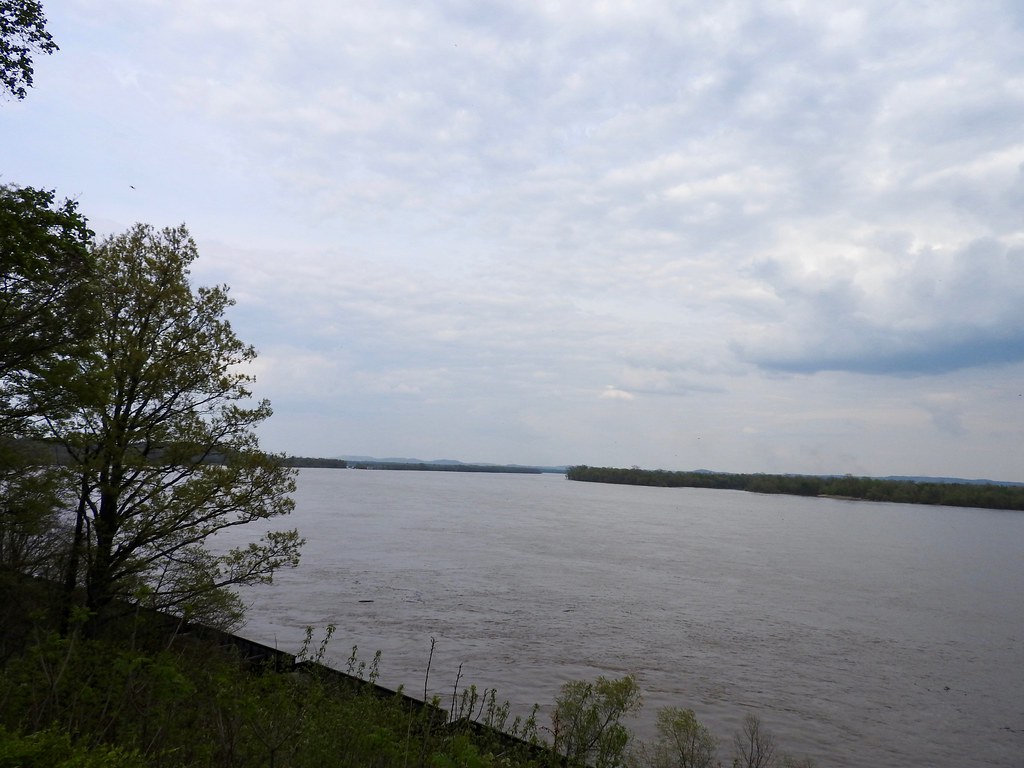Now I needed to execute my ambitious plan, a long weekend drive that would result in my capture of 24 previously unvisited counties. Friday, the first day, covered fewer miles than Saturday or Sunday. However, I made up for that shorter distance with plenty of sightseeing activities. I’d never traveled between St. Louis and Cape Girardeau, Missouri so I wanted to enjoy this particular route following the Mississippi River downstream.
My flight touched down at St. Louis Lambert International Airport at 9:00 a.m., on time and blessedly routine. My wife picked me up at the arrivals curb and we began our ambitious road trip. I brought an awful cold with me, too. The virus passed through the family in sequence over the previous couple of weeks, from the younger son to the older, to my wife and finally to me. The cold dogged me for the rest of the trip although I kept it mostly in check with antihistamines.
That still improved upon my last trip to St. Louis. I got stuck there on September 11, 2001, as airlines ground to a halt after the horrific events of the day. It led directly to a long drive I called The Dreadful Road Trip. Now, I finally returned to the city however briefly after an absence of fifteen years.
Crown Ridge Tiger Sanctuary

I didn’t want to be completely selfish so I tried to include an activity that the kids would enjoy. It depended upon my punctual arrival — certainly not a guarantee with airlines involved — although it worked out this time. We had two hours to get from the airport to the Crown Ridge Tiger Sanctuary in Ste. Genevieve for the first tour of the day. We made it easily, with several minutes to spare. Sometimes everything lines up just right.
This sanctuary provided a caring home for tigers (and one lion) that they rescued from unhealthy situations. Sometimes people wanted to raise tigers or other exotic animals as pets. They got tired of their pets, the animals grew too large or aggressive, or whatever. Other times, little roadside attractions featured wild animals as babies in petting zoos, and of course they matured into full-sized adults, no longer cute. Neglectful situations sometimes resulted. Sanctuaries then offered hope by serving as healthy places where animals could spend the remainder of their years in peace. Unfortunately, raised in captivity, they could not be returned to the wild.
If the photo makes it seem like the tiger lived in a small cage, take heart because this corner served as a corral to funnel the tiger into an indoor space. The larger part of the yard appeared off to the left, beyond the range of the camera.
Crown Valley Brewing & Distilling

Longtime readers of Twelve Mile Circle know that I count many things, including breweries. The kids got their tigers, now I got my beer.
The tour of the tiger sanctuary ended around noon so we headed to our next activity a few miles farther west. A brewery and a distillery? Count me in. Crown Valley Brewing and Distilling offered a convenient stop for lunch, and a chance for us to split a sampler.
It seemed like a big place, much larger than the average craft brewery, although I’d not seen their products before. Their range must not extend to the East Coast. Nonetheless we enjoyed our stop and I could add it to my brewery visit map. I noticed that my brewery total began to approach 400. I wouldn’t be able to hit that landmark during this particular trip. It will happen soon enough though, I’m sure.
Bollinger Mill State Historic Site

I also like to visit covered bridges. I’ve bored 12MC readers with these objects a number of times before. Remember Western Virginia and New Hampshire, as examples? The Bollinger Mill State Historic Site in Cape Girardeau county offered yet another opportunity. It included a large historic mill combined with an adjacent covered bridge. That, I couldn’t miss.
First, we toured the mill. It dated to the beginning of the Nineteenth Century although the present structure arose right after the Civil War. Union forces burned the original mill because Bollinger’s descendants sympathized with the Confederacy and provided flour to help its cause.
We received a nice, personalized tour of the building too. I guess very few people wanted to visit on some random Friday afternoon outside of tourist season so we used that to our advantage. The docent actually locked the front door, put up a sign telling others to come back later, and then led us through every floor of the mill from top to bottom.
The Whitewater River powered the mill, and likewise people needed a bridge to get across its 140 foot width. The Civil War halted construction of the bridge so it wasn’t completed until 1867. By that time a settlement existed near the mill, named Burfordville for a local resident, John Burford. The bridge took the name of the village and it became the Burfordville Covered Bridge. It’s been restored a couple of times over the years although it’s too fragile for anything other than pedestrians today.
From there, we took the brief jog to capture Bollinger County as described earlier. Did the opportunity to cross into one more county influence the trip to the mill, or did the mill influence the jog to Bollinger? I’ll never tell.
Cape Rock

How did Cape Girardeau get its name? Well, both a cape and a Girardeau existed, historically. France once owned this stretch of river as part of its vast colonial empire extending through the North American interior. In 1733, Ensign Jean Baptiste de Girardot, stationed at Kaskaskia, opened a trading post on the far extreme of the frontier. He chose a rocky promontory easily visible along the river. A town would eventually grow there, and appropriated his name as well as the geographic feature.
Ironically, the actual cape, the prominent landmark rock visible from so far away no longer exists. They needed a railroad along the river so they destroyed the outcrop to make room for it. That’s how they rolled in the Nineteenth Century; blowing up the very namesake of the city in the name of “progress.”
Nonetheless, the bluff where the trading post once stood still exists. The city marked the spot with Cape Rock Park. We finished the first day’s drive at the park atop the bluff, gazing upon the swiftly flowing Mississippi River.

Leave a Reply